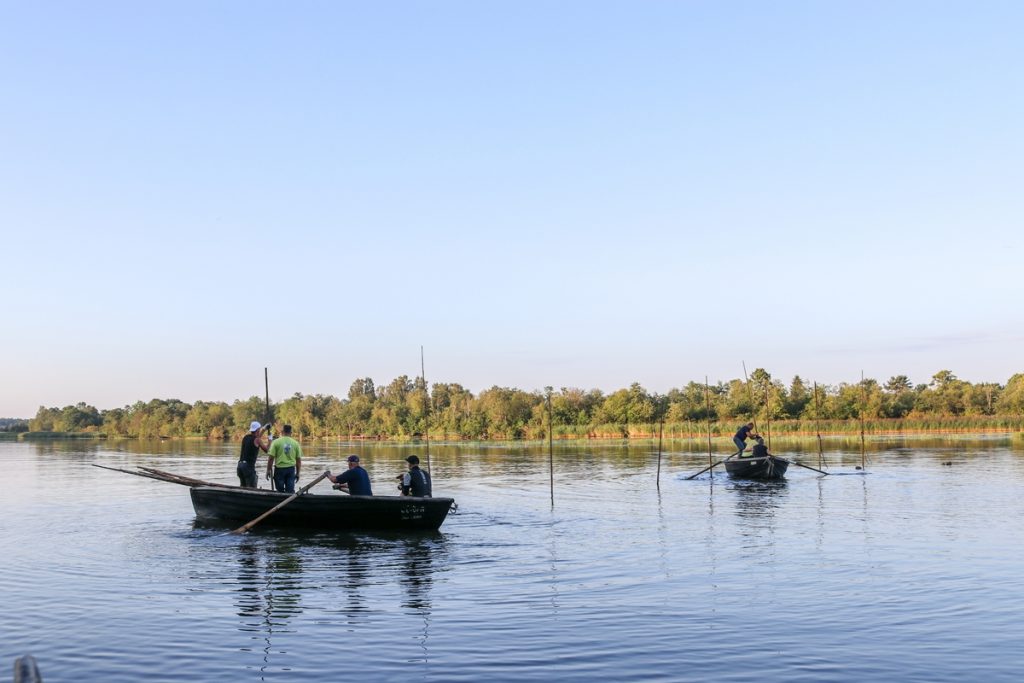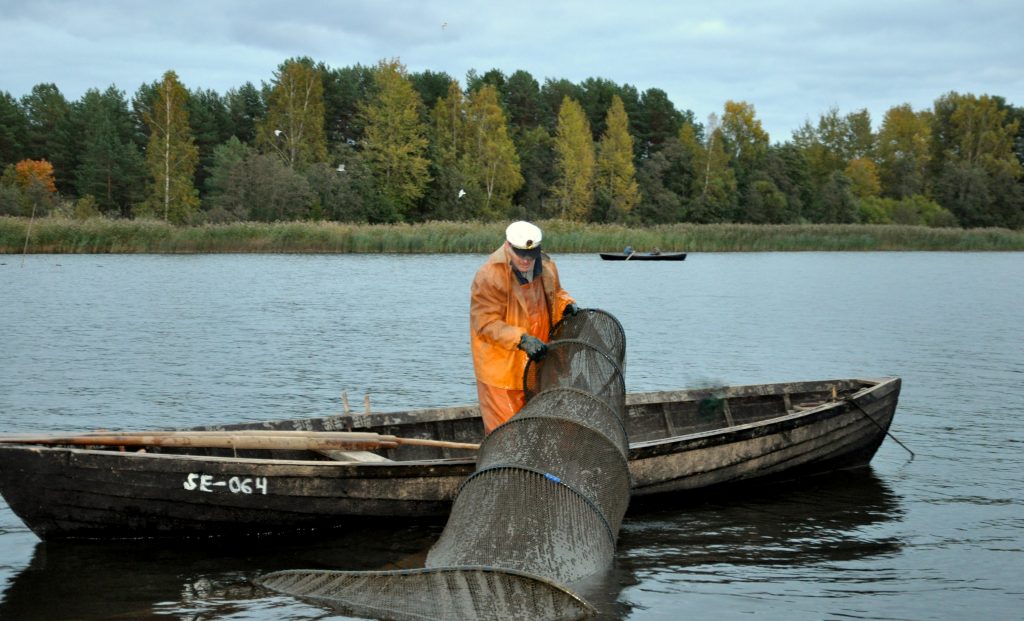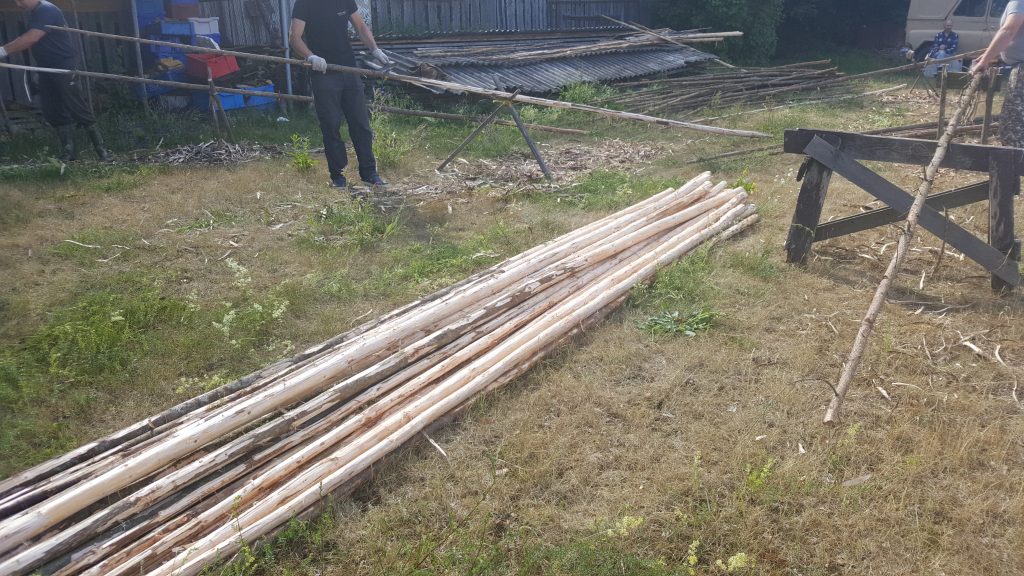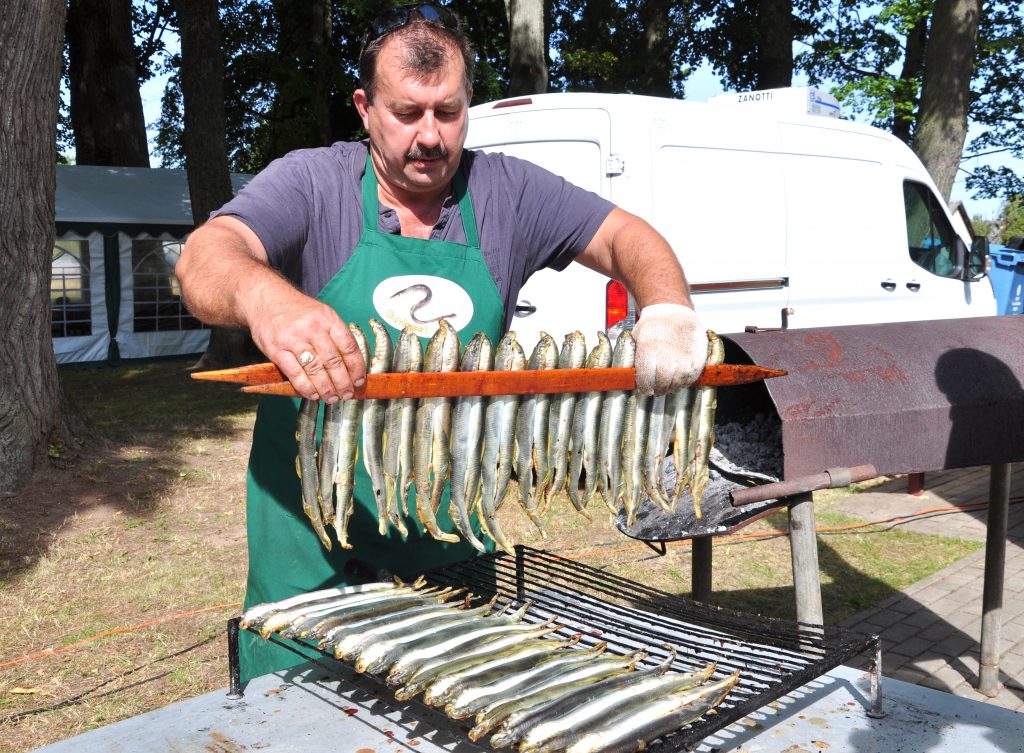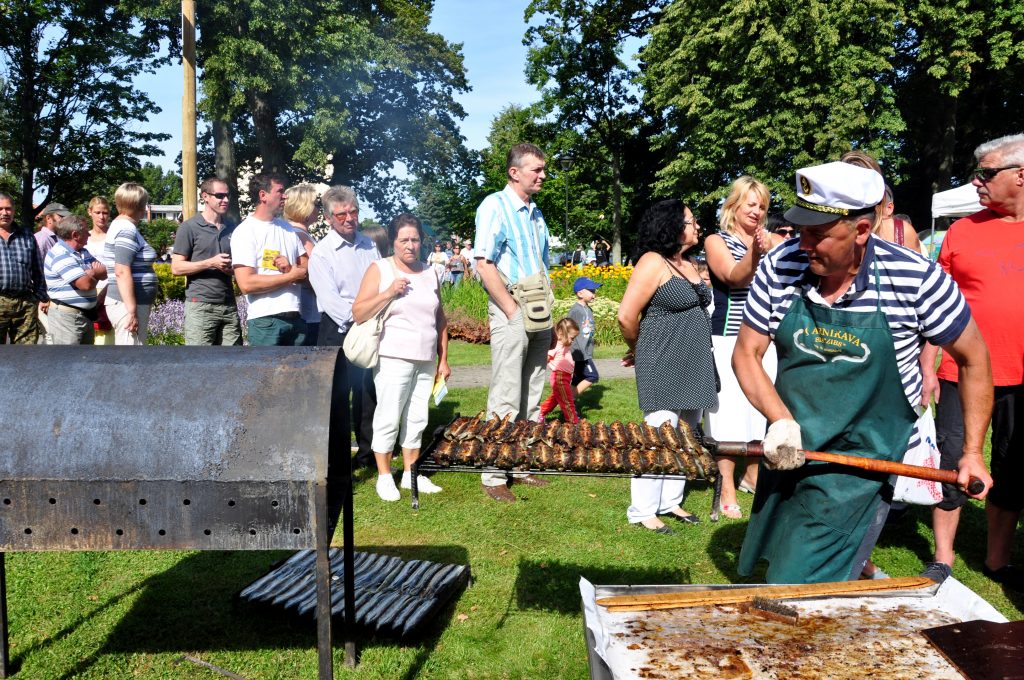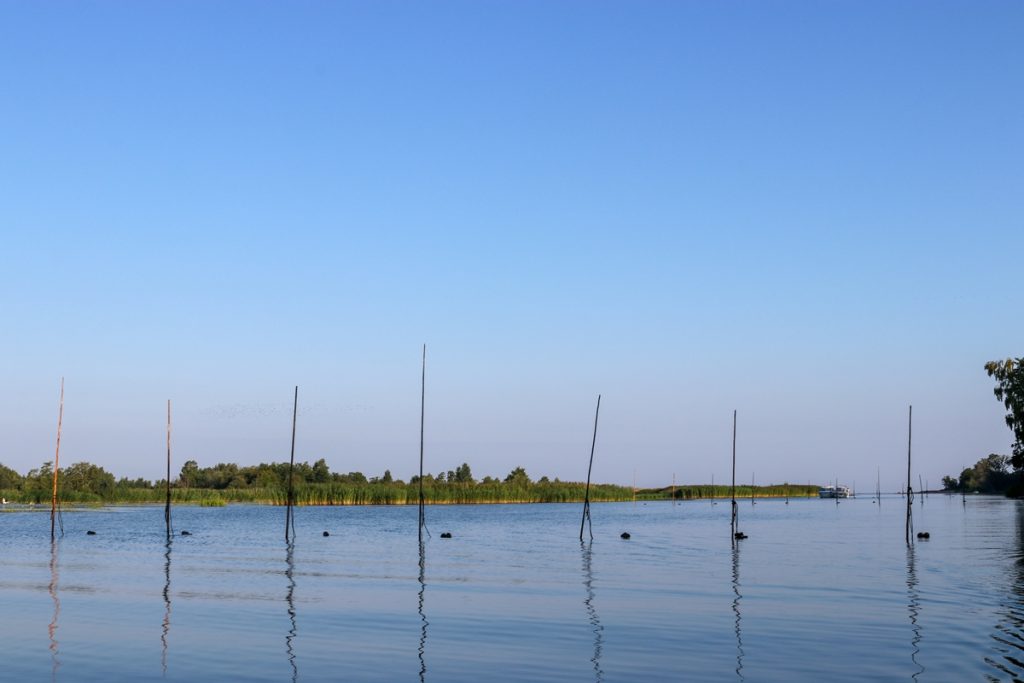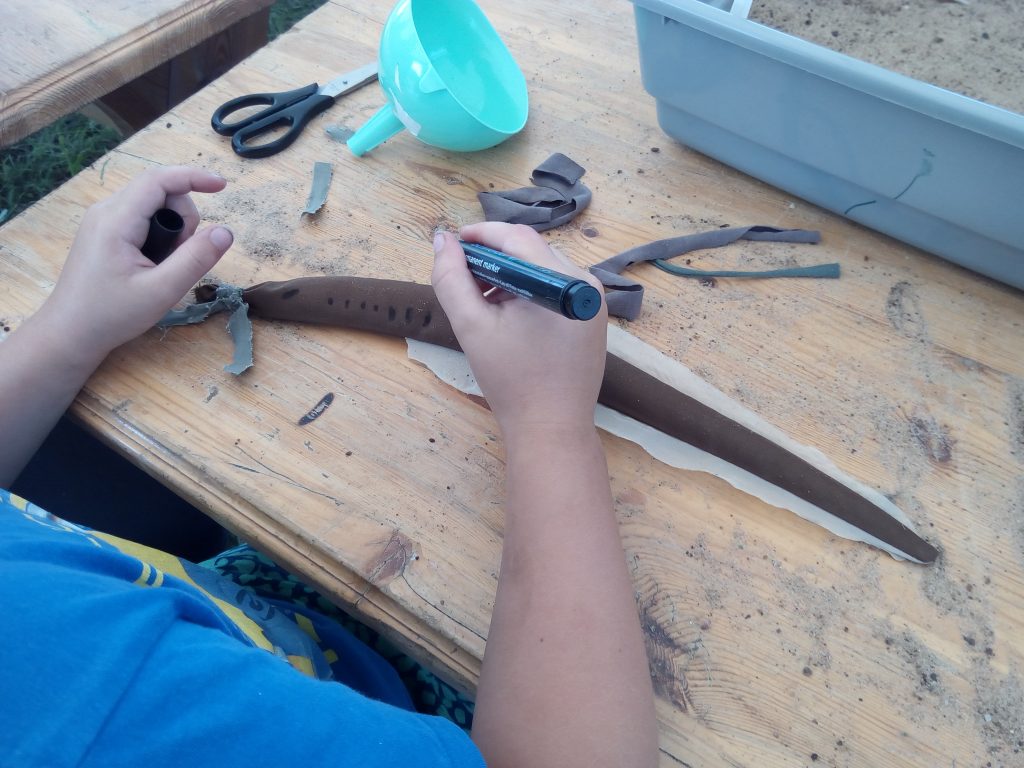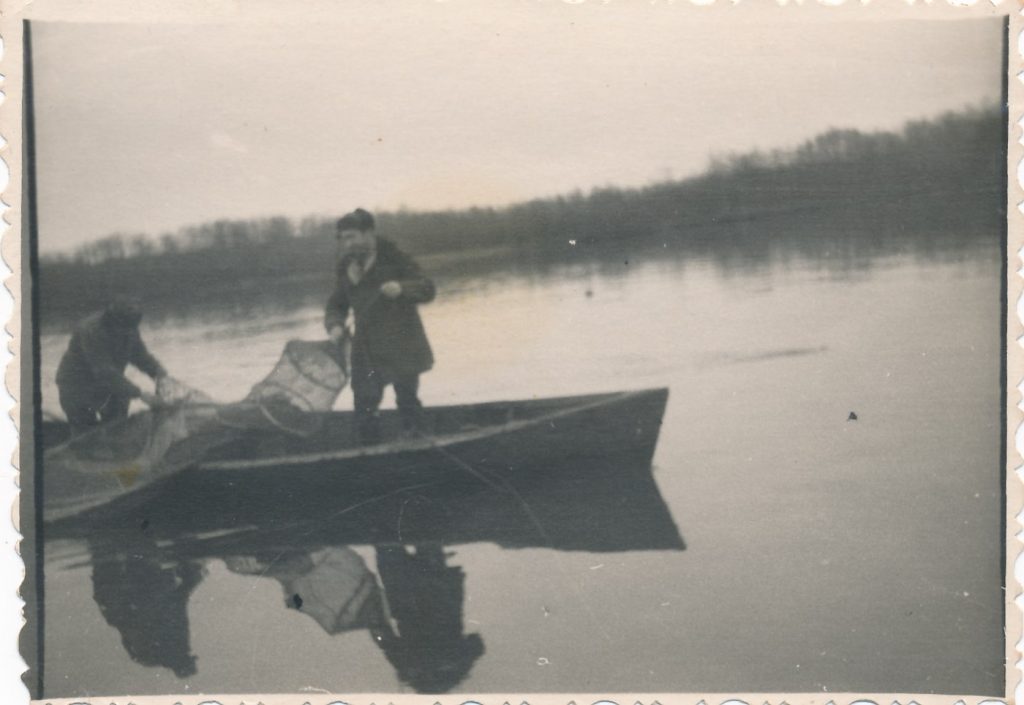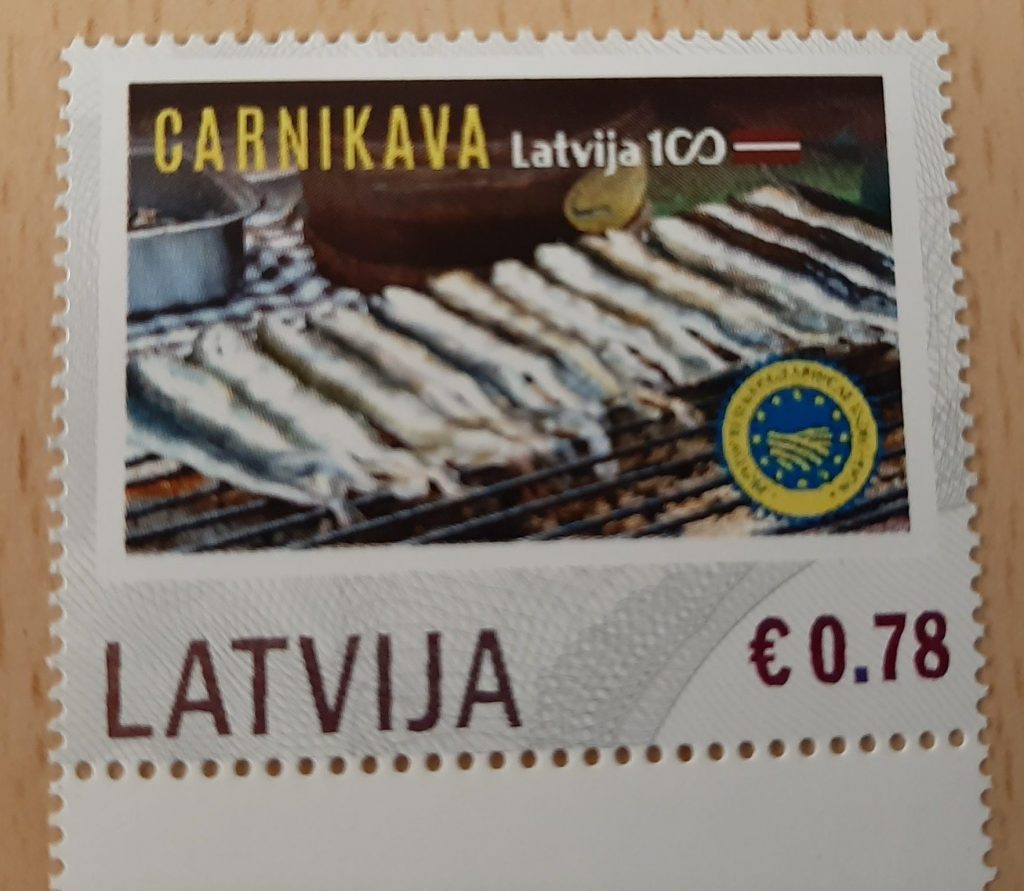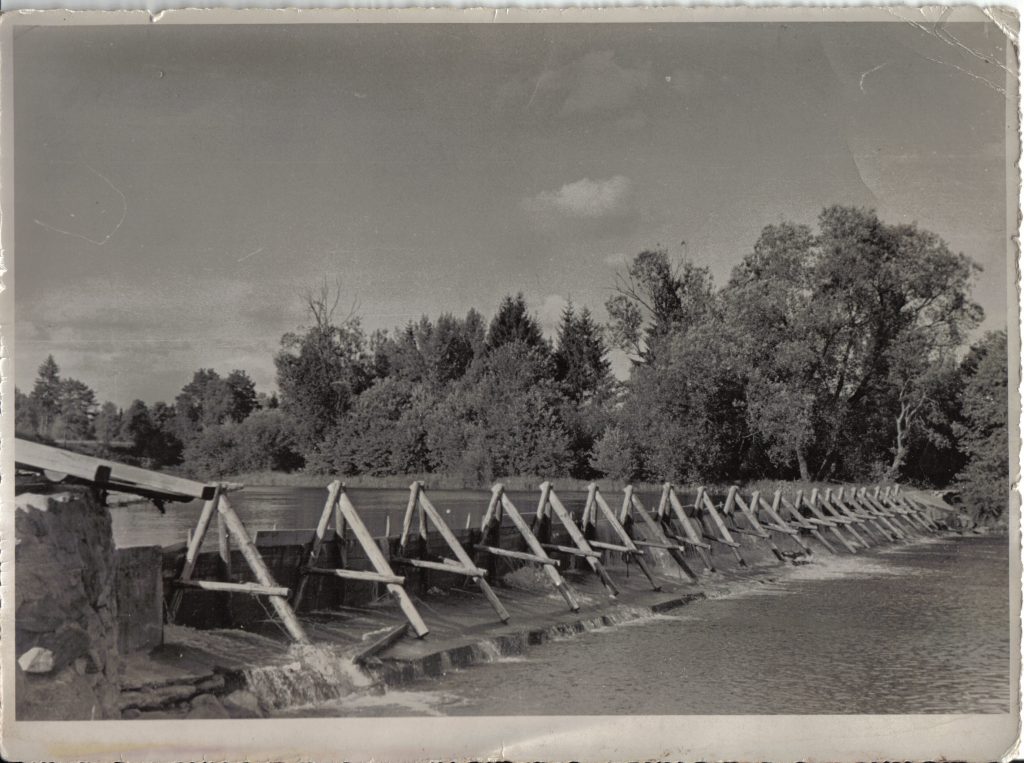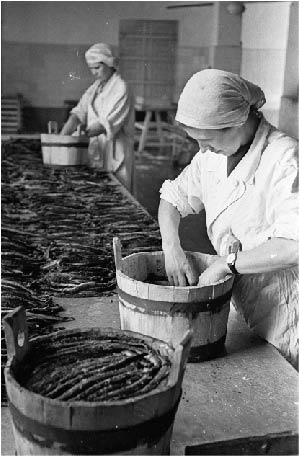Author:
Olga Rinkus
Social practices, rituals and festive events
Traditional kitchen
Traditional craft skills
Knowledge and practices concerning nature and the universe
Title
Lamprey Fishing and Preparation Skills in Carnikava (2019)
The Carnikava lamprey. The Carnikava lamprey is the popular name in Latvia for the European River lamprey (Lampetra fluviatilis) for which the traditional fishing season since ancient times has been from the end of summer until spring - the lamprey spawn season. Formerly, the Germanized name neunagens or nine-eyes was used; amongst locals, the name Carnikava zutiņš was also used - this word is rarely used nowadays.
Geography
Carnikava parish
In a narrower sense, the people connected to fishing and preparing lamprey in Carnikava are the Carnikava fishermen and lamprey cooks, for whom these activities are both their trade and their way of life. Currently, two fishery and lamprey preparation companies operate in Carnikava. Fishermen also have the knowledge to cook the lamprey as well, but they prepare it only for their own use.
In the broader sense, every person living in the Carnikava municipality relates to lamprey. A company called SIA Taču būda (Weir house) operates in Carnikava; there is a senior dance ensemble Tacis (Weir); there is a homestead in the area with the name Murdiņi (Fish traps). Lamprey has helped people from Carnikava maintain their ties to their motherland even when living abroad: the son of the last owner of the Carnikava manor, Kurt Goegginger, was making fish traps and preparing lamprey in the “Carnikava way” while living in Canada. Uldis Siliņš, a Carnikavian living in exile, recorded unique statements about lamprey fishing and preparation in his book “Mēs esam Carnikavieši” (We’re the Carnikavians).
Significance in community life
Carnikava is not conceivable without lamprey - its fishing and processing has been one of the most important conditions for the economic growth of Carnikava. Carnikava is often referred to as the Lamprey Kingdom.
The Gauja River lamprey caught and prepared in Carnikava has always been regarded as the best in Latvia. In 2015, the lamprey was included in the European Union Register of protected designations of origin and protected geographical indications. The designation Carnikavas nēģi, or the Carnikava lamprey, refers only to lamprey caught fresh with fish traps from 1 August to 1 February at the mouth of the Gauja River and prepared in Carnikava.
The traditional Carnikava method of lamprey processing has changed less than lamprey fishing techniques.
The lamprey is prepared according to an old recipe, the first written records of which date back to the nineteenth century, but it was in use already long before that.
The lamprey is cooked in an oven on alder wood coals, then placed on a gridiron in two rows and grilled for four to five minutes on each side until golden brown.
The grilled lamprey is then placed in a container, hot water is poured over it, salt is added, and everything is sautéed until the lamprey is soft. The liquid is then removed, the lamprey is cooled and placed in a wooden bucket (a kubliņš).
The now-gelatinised liquid from the sautéing process is added to the contents of the kubliņš and a special press is added to the lid of the kubliņš so the lamprey is under pressure and its fat mixes with the gelatinised liquid, thus achieving the unique flavour of the Carnikava lamprey. When the lampreys were prepared at home they were flattened with a wooden plank before placement in the bucket, while the factories used different types of presses.
The Carnikava lamprey is therefore also called the flat lamprey. Today, the lamprey is prepared according to the traditional recipe. The recipe has not changed except that the addition of gelatine is now allowed, which was not in the historical recipe.
The name Carnikavas nēģi is used for grilled lampreys in jelly if the product consists of 70% lamprey and 30% jelly. Nowadays, lamprey is packaged not only in wooden kubliņš buckets, but also in in plastic boxes in a wide range of net weight - from 0.270 kg to 10 kg. In the time that the lamprey spends in its journey from the fish trap to the table, it is “embraced” by the hands of fishermen and cooks at least 7-8 times. Usually, each lamprey cook has a specific fisherman from whom they buy the fresh lamprey.
Activities
Historically, the lamprey in Carnikava were caught by local fishermen and prepared – grilled and sauteed in jelly – by the family of the fisherman, passing on the skills from generation to generation.
Historical records mention lamprey fishing in Carnikava already in the 17th century. The lamprey fishing season started in late July or early August. The Carnikavians have long had a saying “when rye is in heaps the lampreys are in fish traps”. Lamprey weirs (tači) were made of wood. Lampreys were caught with wicker fish traps that were attached to the weirs.
Today, Carnikava fishermen use a different method adjusted for the environment—long mesh (net) fish traps. Instead of laying weirs, they drive long wooden poles, bostagi, into the riverbed. The length of these poles depends on the depth of the river and can reach eight metres.
Both historically and today, fishermen acquire and prepare the wood themselves. Along with the poles or bostagi, the fishermen also drive in backpoles, and once the lamprey fishing season begins, they attach the fish traps to the poles. Continuing the tradition, the fishermen prepare and mend their own mesh traps.
Beliefs, rituals, and unwritten rules
Fishermen still use the wisdom of their ancestors to find the best fishing spots and determine the influence of weather on the fishing. Since the Gauja riverbed changes every year, fishermen need to constantly find new fishing spots.
Passing on and transferring skills
Today, only some of the descendants of the ancient fishermen's families are working in their trade, so there is a search for young locals who are willing to become Carnikava fishermen in the future and inherit the skills and knowledge of previous generations.
To honor the Carnikava lamprey and safeguard the local traditions, the Carnikava lamprey has been on the Carnikava municipality coat of arms since 2010.
Starting with 2001, the lamprey fishing and preparation traditions are being popularized by holding a unique event - the Lamprey festival. Each year, the local community participates in the special Lamprey Festival Parade which strengthens the community and shows local support for the lamprey tradition and efforts to popularize it.
The Carnikava lamprey has always been seen as a real delicacy and the pride of all Carnikava people, even sometimes serving as a local currency. These days, the Carnikavians often choose lamprey in jelly as a gift when visiting near and far lands.
History
The Carnikava lamprey fishing evolved according to socioeconomic conditions, adapting to the age and transfer of land ownership. Historically, lamprey was most likely caught using weirs and fish traps almost everywhere.
The biggest difference between areas was the construction of the weir and the trap, which differed depending on the peculiarities of the riverbed in each area. The wicker fish traps differed by shape. In Carnikava, they were large and round. Nowadays, the Carnikava net traps still differ in shape, size and construction from lamprey traps used in other areas.
Not only were the catching techniques different, but also the names of the parts and tools of the weirs. When Carnikava was under the rule of the Carnikava manor (until 1918), all weirs were the property of the estate with the two first weirs “feeding” the manor and the rest rented out to fishermen. The manor controlled both the volume of the catch and adherence to fishery rules. In the spring before the ice begins to drift, the weirs were dismantled so they would not cause ice to pile up and be carried out to sea along with the ice. The process was repeated every year. Today at least five weirs are built, each with its own name.
The frying shop in Carnikava was most likely opened in the late nineteenth century, but the Fishing Industry Society opened its new factory building in 1935. The companies also exported the Carnikava lamprey to Europe.
Interestingly, spots on the weirs were even rented to Rigans, but only Carnikavans tended them.
Fishing lamprey with weirs continued into the Soviet times; however, mesh fish-trap fishing also became popular. The last weir in Carnikava was built at the beginning of the 1970s. During the Soviet period, two fishing brigades worked on the river, out of which two fishing companies emerged. The lamprey processed in the Carnikava fish factory was mainly exported to Moscow and Leningrad (now St. Petersburg).
Carnikava has always been not only the land of lamprey fishing but also lamprey tasting. Since the late nineteenth century, people have been travelling to Carnikava for the purpose of tasting lamprey. The construction of the railway in the late 1930s brought the arrival of tourism-oriented “lamprey trains” to Carnikava. Guests were offered tours of the weirs, visits with the cooks, as well as lamprey tasting.
During Soviet times, when Carnikava lamprey was not freely available in stores, Rigans visited the local fishermen who secretly fried and sold the local delicacy. There are stories that the bags of Rigans were sometimes searched at the train station and the homes of fishermen were raided by inspectors.
Nowadays, the lamprey branding is still widely used in the tourism industry, not only during the Lamprey Festival. In the Carnikava tourism information centre, one can buy souvenirs shaped like lamprey or with lamprey prints, and the local crafts are adorned with lamprey motifs. Tour agencies organize special “Lamprey trips”, visiting the exhibitions in the museum of local history, exploring the programme Nēģu stunda (Lamprey hour) and participating in grilled lamprey tastings.
Additional Information
Lamprey fishing is tied with observing the natural cycles, old wisdom and traditions.
KNOWLEDGE OF NATURE
The start of lamprey migration and its intensity has a proven correlation with the wind direction, moon phases, water levels, and changes in the riverbed, as well as other knowledge of nature. Just like in the olden days, the local Carnikava fishermen forecast the behaviour of lamprey in different circumstances. For example, it is widely known that it is easier to catch lamprey during North or North-Western winds in waters clouded by rain, and that the traps will be empty after a night with full moon. There are old observations around lamprey preparation as well, for example, lamprey should not be washed in freshwater because it makes removing the mucus impossible and even exacerbates the production of mucus in lamprey.
ORAL TRADITION AND SPECIAL LEXICON
When leaving for fishing, the fishermen still observe old beliefs: for example, that lamprey should not be caught on certain days of the year; also, one should never reveal the exact size of the catch.
Historically, when lamprey was caught with weirs, each part of the weir - the stake, pole and fastening had its name. Nowadays, as wicker fish traps have been replaced with net fish traps, the poles that are driven into the riverbed to attach the traps to them are called bostagi. But formerly, the word bostagi referred to the thinner poles which were driven into the riverbed between two thicker poles - stāvkājas (“stand-legs”). Even though nowadays the fish traps are made of net, not osier wicker, the traditional names murds and kurvis (basket) are still used. Interestingly, the name “zutenis” referred to both the lamprey and the wooden sticks used to flip lampreys while grilling.
CULINARY TRADITIONS
In Carnikava, lamprey has long been eaten either freshly grilled on gridiron or prepared in jelly, instead of smoking, marinating or preparing it in any other way, as is done in other regions. Over time, Carnikavians also started to come up with and experiment with more modern culinary recipes. Nowadays, during the Lamprey Festival, participants also prepare lamprey soup; there are also several lamprey salad recipes, yet still the old preparation traditions prevail.
Masters
Two fishing companies (SIA) currently operate in Carnikava – SIA Leste and SIA Grif 93. Both companies emerged from crews working in Carnikava in Soviet times. Five years ago, Carnikava still had 20 working fishermen, but now the number has shrunk to 14. There is only one active fisherman in Carnikava who is younger than 35.
SIA “Leste” currently employs eight people:
• Aldonis Lūkins (b. 1969);
• Artūrs Jakobsons (b. 1986);
• Andris Miglāns (b. 1968);
• Alberts Skavenecs (b. 1936);
• Jānis Krastiņš (b. 1938);
• Jautris Rikards (b. 1944);
• Normunds Lūkins (b. 1962);
• Raimonds Lācis (b. 1973).
SIA Grif 93 currently employs six people:
• Vladimirs Burdiļovs (b. 1939);
• Ēriks Liepiņš (b. 1960);
• Jānis Neilands (b. 1943);
• Ārijs Švarcbahs (b. 1961);
• Harijs Švarcbahs (b. 1961);
• Agris Freibergs (b. 1964).
The retired Carnikava fisherman Arvīds Ozoliņš (born 1938) also knows the old weird building skills - he participates in activities aimed to popularise traditional skills (conferences, video production, TV productions, etc.)
Three Carnikava fishermen participate in programmes organized by the Carnikava Local History centre: Nēģu stunda (The Lamprey Hour) and Ciemos pie Carnikavas zvejnieka (Visiting the Carnikava fisherman): SIA Grif 93 fisherman Ēriks Liepiņš, the youngest fisherman of SIA Leste – Artūrs Jakobsons, as well as the retired fisherman Arvīds Ozoliņš.
Currently, five lamprey cooking companies are actively operating and advertising themselves in Carnikava. A few of them also work with licenced lamprey fishing. These are mostly family ventures with 2–4 permanent workers:
• SIA “Zibs”;
• SIA “Krupis”;
• i/u “Gundegas IP”;
• SIA “Gaujas nēģi”;
• Gaļina Ļevočkina.
Just a few years ago, SIA Gaujas Krasti and IK Dietlavi were also still working with lamprey preparation in Carnikava. SIA Gaujas Krasti was liquidated in 2017, and IK Dietlavi is currently not processing lamprey and are not sure of the future as the owner of the company is a man of more than 80 years of age whose descendants are not planning to work in lamprey preparation. Another entrepreneur, Jānis Kartupelis (SIA Gaujas nēģi), also reveals that his trade will not be inherited by anyone in the family.
Agencies and institutions
• The municipality of Ādaži county in particular – the unit of the Adaži county for Culture “Carnikava local history centre” and the tourist information centre of Carnikava;
• The society “Smart Carnikava”, includes the youngest, socially active local fisherman Arthur Jakobson. Fishermen and bakers plan to set up a society in the near future so they can work together on preserving the tradition of catching and processing lampreys;
• In addition to ensuring fishing, Lesta Ltd. also fulfils the function of promoting lamprey fishing (contract term with Ādaži local government).
Unfortunately, the other fishing company, Grif 93, went bankrupt a couple of years ago and ceased to exist, which reduced the number of active lamprey fishermen to 6 (!!!). in 2019, the number of fishermen in two companies was 14.
Consolidation
The traditions of the Lamprey Festival and the Fisherman’s Festival continue in Ādaži.
On January 29 and 30, 2022 the event “Lamprey train – an adventure of feeling and taste in Carnikava” was held, reviving and promoting the 20th century traditions. The event highlighted culinary traditions, created an audio guide and a publicly available video (5 hours) in particular.
A permanent outdoor exhibition has been established in the shelter (CNC) of the Carnikava Novada Research Centre – a devotion to the catching of lamprey and related features throughout Latvia.
On July 8, 2023 local fishermen attended the “living cultural Heritage workshops” international festival “Baltica” with CNC representatives.
Fishermen, bakers and representatives of the CNC have actively participated in good practice exchange visits and other activities within the framework of the Cherish project (the project continued until 2023), as well as activities of organisations of the association “Land of the Sea” During COVID-19, remotely.
In 2022 young people from local schools hosted a Minecraft Tournament, where the creative environment had to build as precise a Carnikava fishermen's motorboat as possible within 3 hours, job assessors and award instructors were local fishermen, the works exhibited in the CNC's barn building alongside NKM's “Household Table” exhibition.
In 2023, fishermen created a lamprey tagline model in CNC's backyard, unveiling it at the 2023 Lamprey Festival. This year, BIOR scientists also attended the Lamprey Festival with activities for promoting lamprey and presenting research materials.
Lampreys were promoted locally, nationally, and internationally too – in newspapers and the press, radio and TV. The book, the Lamprey Bible, provided summarized information about Carnikava.
Two CNC Museum pedagogical programmes with the participation of local fishermen continue and develop, with children from neighbouring countries and Scandinavia also participating. Local fishermen set up a special service for tourists, during which it was possible for those interested to go with the local fishermen and check the lamprey pots.
Despite the drastic decline in the number of lamprey bakers and fishermen and a number of failed lamprey-catching seasons (losing SIA “GRIF 93”), work and collaboration continues, local fishermen and bakers continue to participate actively in lamprey-catching and coastal culture promotion events in Latvia and beyond, along with former and existing employees of the CNC, as well as members and active supporters from the local Community (the last event involving a local fisherman, A. Jakobsons, was Fishners of the future, March 2024, Belgium). As a result of the ATR, the municipality of Carnikava was added to Ādaži county, but despite discussions in society and a sense of insecurity, traditions of both the Lamprey Festival and the Fisherman’s Festival continue. The level of local patriotism is growing among the local population, and people in Ādaži are also associating themselves more with the coastal culture. CNC visitor numbers have reached nearly 10 thousand visitors in 2023 (CNC visitor numbers were around 6,300 as of 2019), not including areas where you can get to know the new tagline model and other coastal heritage presenting objects in the backyard and shed (SAM project SAM 5.5.1. “Conservation, protection and development of important cultural and natural heritage and the development of related services”). 2024 The head of the CNC received an opinion from Ādaži City Council on strengthening the local Community. Local fishermen and bakers plan to form an association in the future so that they can operate in a planned way, attracting funding from national and EU structural funds.
The maintenance of the element and its promotion in the field of cultural heritage was supported almost entirely financially by the Carnikava Municipality government with commitments taken over and fulfilled by the municipality of Ādaži. The activities of the CNC, pedagogical programmes and royalty agreements are concluded with fishermen for the preparation, development and delivery of programmes.
Local fishermen and bakers support the maintenance of the element on a daily basis by repairing tweirs, presenting lamprey baking skills, participating in the days of home cafes, telling the local traditions of both Latvian residents and also partners from abroad (fisherman - Artūrs Jakobsons and SIA "Zibs", IK "Gundagas IP" and the younger generation of SIA "Kurpis" - in English).). The CNC, fishermen and bakers were visited by two VAR ministers along with foreign guests, state President Viesturs Rinkevics, etc.
The inclusion of lamprey catching skills in the NKM list is associated with the catching and processing of Carnikava lamprey in the Register of Protected Geographical Indications (PGI), interacting and having a positive impact on the promotion of both lists. Activities carried out by LLC “Latvian Rural Advisory and Training Centre” (LLKC), and especially project manager/fisheries consultant Janis Kravalis in the field of strengthening the PGI brand, indirectly support the capture and processing of lamprey as an element of the NKM list. LLNC representatives often mention the NKM in their activities (videos, media projects, experience trips, culinary events). Thank you also to Ginta Dzerkale, senior expert in the biotechnology and quality department of the Ministry of Agriculture, representatives of the society “Cheese Club” for including lamprey as a culinary heritage in their materials and editions.
The Vidzeme Tourism Association (VTA) and the Pierīga Tourism Association (PAT) promote lampreys as a tourism product on the local and international market. The Riga Planning Region (RPR) and the Ministry of Culture are always happy to cooperate and provide informative support (not only within the CHERISH project), and the association "Jūras zeme" actively presents the traditions and includes the preservation of cultural and fishing heritage in its strategy. Fishermen Aldonis Lūkins and Artūrs Jakobsons are active members of the association.
Continuation/development
The CNC will continuously carry out these types of activities as part of its day-to-day work, which is in line with the Ādaži County Development Program 2021-2027 Action Plan (V11.3: Research, development and integration of heritage sites into tourist sites). Type of financing – funding granted by the CBC of the Ādaži County Council, possibly – funding of the Fish Fund and THE NCF for events and exhibition.
• Research into the tradition of catching, processing, propagating and using lamprey in other regions of Europe and the world, comparative analysis, presentation of the results of research to the public in the local edition “Ādaži's messages”, publications in 2–4 years. Publications on social media;
• Collaborating with scientists at the BIOR Institute in the field of research into modern lamprey catching and propagation processes, recording changes in research and propagation. In addition, in case of attraction of financing – the underwater fixation of the lamprey catching processes, informing the public (Latvian fish yearbook, etc.);
• Research of objects from Carnikava in the collection of the Daugava Museum, documentation of results. Research of poaching gear in co-operation with colleagues of the Daugava Museum. Development and presentation of a joint exhibition, tourist product or event to the public. The exhibition or event is scheduled to be held in 2025;
• Recording, research, digitisation of the memory stories of employees of the Carnikava fish processing plant. Continuation, documentation, research and documentation of festive traditions. Presentation of research results to the public in publications, festival events, lamprey festivals.
The local fishing Community (planned to establish an association in May 2024) plans to carry out annual research with the municipality of Ādaži in the spring/summer – season, in parallel with the restoration of the tagline model and restoration process, as well as the tools of other European regions, using the acquired knowledge in practice. The research takes place during collaborative events and coastal heritage presentation tours. Source of financing – own funding of fishermen, co-financing of Ādaži County Council, co-financing of the association “Land of the Sea”, co-financing of the NCF. Wider presentation of results to the public – once a year in the Lamprey Festival.
The CNC performs these types of activities on an ongoing basis as part of its day-to-day work and in accordance with the Annual Action and Activities Plan, which is in line with Ādaži County Development Programme 2021-2027 Action Plan (U11.3.6: to support the preservation of cultural and historical values, to build a modern tourism offering based on ancient traditions. C11.3.6.2. Promotion and transfer of the coastal heritage of fisheries through the creation of a modern tourism offering based on a long tradition). Type of financing – funding granted by the CNC of the Ādaži municipality council, financing of the city council for the organisation of large events (Festival of Forests, lamprey), possibly – co-financing of the Fish Fund for the new establishment of the household house exhibition, the VKKF – measures for promoting inter-community co-operation, supporting not only the initiatives of the local government, but also the community of fishermen and bakers.
• Maintaining the traditions of lamprey festivals and expanding the scope of the event, also bringing in foreign experts and participants from neighbouring countries in cooperation with BIOR;
• Promotion of the interests of young people, continuation of competitions, (modelling competition for young people), complementarity of two museum pedagogical programmes of the CNC relating to the theme of lamprey, organisation of competitions is scheduled to take place 1 time a year, complementarity of museum pedagogical programmes involving lamprey fishermen is ongoing;
• Developing and complementing the new CNC lamprey exposure with advanced technical solutions to attract a wider audience of visitors. The development of the exhibition is planned in several rounds by 2028;
• Restoration of the Flea Tavern building and establishment of the office house, keeping the unique lamprey baking oven. The project “renovation of the Flea Tavern” is included in the society's “Land of the Sea” community-driven local development strategy for 2023–2027.
The local fishing community (plans to set up an association in May 2024) with Ādaži local government and CNC and BIOR intend to implement the following measures to promote the recognition of the element:
• Establishment of the fishermen's and bakers' community society in May 2024 to expand activities, strengthen the community and attract co-financing from the NCF;
• Expansion of tourism services and activities. Starting in 2024, local fishermen plan to maintain not only the model of the newly built tagline at CNC, but also lay modern-day mesh hammers for public education purposes;
• Not only the restoration of the model of the lamprey hut, but also the restoration and tarring of the CNC exhibit – a wooden fishing boat for the spring-summer season 2024;
• Promoting Lamprey Resource Recovery (lamprey propagation) processes with BIOR scientists – regular activities.
The objective of the above measures is to preserve a specific element which differs from other elements, because in the case of lampreys conservation depends not only on the chances of inheriting traditions and on the future interest of humanity in the element, but also on the benefits of nature, the environment and the results of pollution of waters, and this is a truly dangerous trend and a direct threat to the future existence of the element. In order to preserve the element in Carnikava, work together and in several directions simultaneously, highlighting both the component of the cultural heritage of the element (broad measures, measures to strengthen the local community, research, museum experience) and working towards environmental conservation and resource restoration (cooperation with scientific institutions in projects to improve the environment and restore fish resources), as well as in the direction of inheriting traditions (measures to inherit traditions, cooperation with young people to ensure the inheritance of the element), in parallel, promoting the international recognition of the element not only in the field of the capture and processing of lamprey, but also more broadly – in the field of strengthening the coastal traditions of Latvia, the Baltics and Europe, at the level of UNESCO, in the hope that other elements related to the coastal and culinary heritage will join the list of UKM in the future.
Threats
• Changes in legislation regulating the process of catching and processing lamprey may negatively affect local fishermen and cooks;
• The biggest threat is the reduction in the number of lampreys. Lampreys are most threatened by pollution of rivers and marine waters, river dams, poachers, and climate change. According to the data of the BIOR institute, compared to other rivers of Latvia, the number of lampreys will reduce most in the Gauja in the upcoming years;
• The profit made by fishermen depends on the amount of lamprey caught. Additionally, the profession of a fisherman is not prestigious enough. The current forecast estimates that in 2–5 years one of the Carnikava fishermen crews might stop operating;
• The number of cooks is also decreasing. Multiple companies have gone bankrupt due to a lack of local lamprey. The processes are also affected by the buying capacity of locals and interest in lamprey as a local delicacy. If this trend persists in the future, in the absence of promotion and conservation measures, trades of lamprey fishing and preparing are in threat of going extinct, just as the trades of Carnikava rafters and anchormen disappeared.
Applicant
Carnikava Municipality self-government – successor – municipality of Ādaži county (TAIL. 90000048472).
Image Gallery
Video
Publications
Senkēviča, B. (1994). Jāņi – vasaras saulgrieži. Rīga: Zinātne
Tihovska, I. (2009). Ziemas saulgriežu mūzika. Krāj. Praktiskā Ziemassvētku grāmata. Rīga: Kultūrizglītības un nemateriālā mantojuma centrs.
Carnikavas novada dome (2016). Latvijas delikatese – Carnikavas nēģi. (Buklets).
S. Cimermanis. (1964). Nēģu zveja Carnikavā 19.gs. otrajā pusē un 20. gs. Arheoloģija un Etnogrāfija. 161. - 178. lpp.
П. Борисов (1913). Материалы к познанию русского рыболовства. Том 2, выпуск 12.
Siliņš U. (2018). Mēs esam carnikaviesi. Carnikavas novada dome. 260. - 272. lpp., 274. - 279. lpp.
Dzīve pie jūras. Atmiņas un mūsdienu stāsti no Carnikavas novada zvejnieku un nēģu cepēju ikdienas (2017). (Brošūra).
Latvijas PSR Zvejnieku kolhozu savienība (1989), Rīga. Zvejnieku kolhozs Carnikava (brošūra, izdota krievu valodā)
Ādolfs Talcis (1972), Zvejnieku kolhozs "Carnikava". Izdevniecība "Liesma", Rīga (brošūra)
P. Retelis. “Nēģis ceļo tikai naktīs...”. Daugavas Vēstnesis, 23.11.1943, Nr. 273
V. Pastere. “Nēģi – Carnikavas zelts”. Carnikavas Novada Vēstis, 2014. gada janvāris
E. Pētersone. “Novada dārgums – “zutiņš”, Carnikavas Novada Vēstis , 2015. gada marts
S. Baltruka. “Carnikavas nēģiem Eiropas kvalitātes zīme”, Carnikavas Novada Vēstis, 2015. gada marts (213)
M. Sarkane. “Nēģu svētki pagājušā gadsimta 30. Gadu gaumē”. Carnikavas Novada Vēstis, 2016. gada augusts (244)
O. Rinkus. “Nezināmais par zināmo jeb nēģis caur zinātnes prizmu”. Carnikavas Novada Vēstis, 2018. gada janvāris (272)
O. Rinkus. “Carnikavas nēģis XX gs. 30. gadu receptēs un mūsdienās”. Carnikavas Novada Vēstis”. 2018. gada decembris (287)
Websites
http://www.zivis.carnikava.lv/lv – The website provides information on Carnikava fishermen and the protection of fish resources. Several sections have been devoted to the catching of lamprey and lamprey as a geographical product, including the “Lamprey fishing” section where both photo and textual information are found.
http://www.carnikava.lv/ – extensive information on the history of the municipality, Lamprey festival, fishermen, lamprey cooks, etc.

